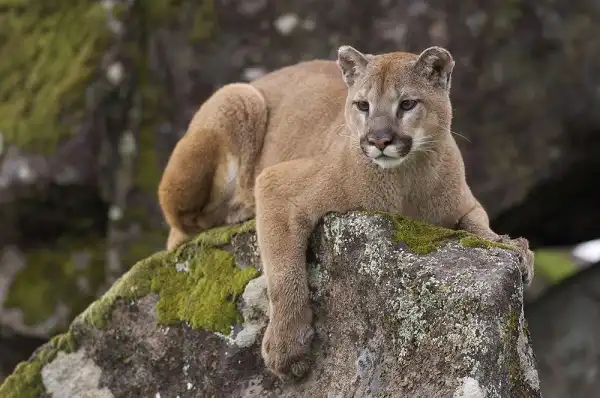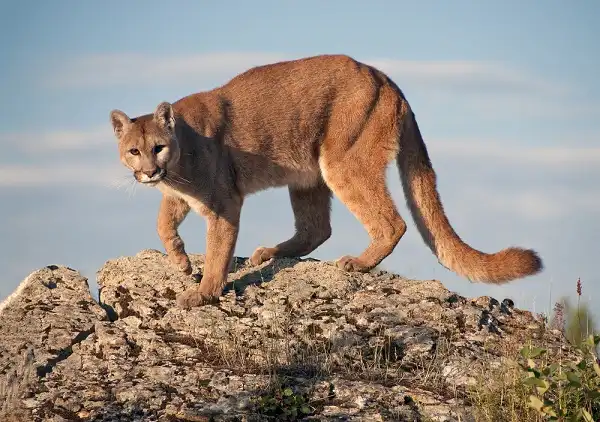At first glance, the mountain lion may seem like a ferocious animal. But upon further observation, you’ll see that this big cat is actually quite shy and reserved. Although they are not typically considered to be a danger to humans, mountain lions should still be respected for their power and strength. Here are some interesting facts about these fascinating creatures.

Mountain Lion Description
Mountain lions are large cats found throughout North and South America. They have a thick coat of tawny brown fur, with lighter patches on the throat, chest, and belly. Male mountain lions can grow up to eight feet from nose to tail and weigh between 75 and 175 pounds. Females are slightly smaller at around five to seven feet in length. Mountain lions hunt primarily by stalking their prey, using a combination of stealth and speed to capture unsuspecting animals. These big cats need large areas of land to roam freely, so protecting their habitats is essential for their survival.
Mountain Lion Habitat
Mountain lions are found across North and South America, in a variety of habitats including forests, deserts, mountains, grasslands, and wetlands. They prefer areas with plenty of cover for hunting, such as dense brush or thickets. They also need sufficient prey to sustain their populations, so the presence of deer or small mammals is important for mountain lion survival. Additionally, they require large territories in order to roam freely and avoid competition from other big cats. By preserving natural habitats throughout the continent we can help ensure that these majestic creatures remain an integral part of our ecosystems for many years to come.

Mountain Lion Diet
Mountain lions primarily feed on deer and other small mammals, such as rabbits and squirrels. They also occasionally hunt for birds, lizards, and even fish. As apex predators, they play a critical role in maintaining the balance of their local ecosystems by controlling prey populations like deer. In areas where mountain lion populations have been reduced or eliminated due to hunting, deer numbers can become too high resulting in overgrazing of vegetation which can negatively impact the habitat for other species.
Mountain Lion Size
Mountain lions can vary in size, depending on the particular subspecies. Generally, they measure around two to three feet tall at the shoulder and six to eight feet long from nose to tail. They weigh anywhere from 75 to 175 pounds.
Mountain Lion Lifespan
The lifespan of mountain lions in the wild is typically 12 to 15 years, although they may live longer than 20 years in captivity. They reach sexual maturity between two and three years of age and can live independently for some time before finding a mate.
Mountain Lion Behavior
Mountain lions are typically solitary creatures and prefer to live alone, except during mating season. They tend to be nocturnal or crepuscular, meaning they are most active at night or in the early morning hours. They have an excellent sense of smell and hearing and can often detect prey from up to a mile away.

Mountain Lion Speed
Mountain lions are capable of running up to 40 miles per hour and jumping distances of over 15 feet. They typically hunt alone, using a combination of stealth and speed to capture unsuspecting animals. These cats have been known to take down prey as large as deer and elk!
Mountain Lion Hunting
Mountain lions primarily hunt by stalking their prey. They use a combination of stealth and speed to close in on unsuspecting animals. Once they are close enough, the mountain lion will pounce and use its sharp claws and teeth to incapacitate its prey.
Mountain Lion Threats
The main threats facing mountain lions include habitat destruction, hunting, road mortality, and climate change. These big cats need large areas of land to roam freely, but human development has reduced their natural habitats across much of the United States. Additionally, mountain lions are sometimes targeted by hunters or poachers looking for trophies or meat. To help protect these majestic creatures, conservationists have advocated for greater protection of their habitats and stricter enforcement of laws
Mountain Lion Reproduction
Mountain lions reach sexual maturity between two and three years of age. The mating season typically takes place in the spring, when mating pairs stay together for several days or weeks. After a gestation period of around 90 days, females will give birth to a litter of one to six cubs. The mother will raise the cubs on her own until they are ready to leave at around 14 months old.

Conclusion
The mountain lion is an impressive and majestic animal. While they are not usually considered a threat to humans, it is important to remember that they are powerful predators and should be respected as such. Being aware of their habits, diet, size, lifespan, behavior, speed, and hunting techniques can help you appreciate these amazing creatures even more.
Frequently Asked Question

